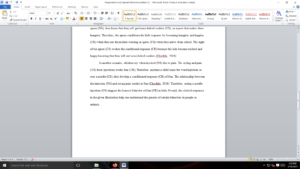In the science of behavior analysis, there are two types of conditioning. Respondent behaviors can be thought of as reflexes that are elicited by stimuli. While operant behaviors can be thought of as behaviors that are maintained by environmental consequences and evoked by environmental stimuli.
- In correct ABC (three-term contingency) format, provide three operant examples and explain why they are operant conditioning.
- In correct format, provide three examples of respondent conditioning and explain why they are respondent.
- State the US -> UR relation.
- State what is the NS.
- State the conditioning process, and that it may need to happen numerous times: NS+US->UR relation.
- State the CS -> CR relation is now created.
- Acknowledge that the US-UR relation hasn’t changed, and that occasional pairing of the NS+US is required for the NS to remain a CS.
Answer preview
Therefore, the apron conditions the kids’ response by becoming hungrier and happier (CR) when they see the mother wearing an apron (CS) when they arrive from school. The sight of the apron (CS) evokes the conditional response (CR) because the kids become excited and happy knowing that they will eat home-baked cookies (Chechile, 2018).
In another scenario, children cry when injected (NS) due to pain. The crying and pain (US) from injections evoke fear (UR). Therefore, anytime a child hears the word injection or sees a needle (CS), they develop a conditioned response (CR) of fear. The relationship between the injection (NS) and crying/pain results in fear (Chechile, 2018). Therefore, seeing a needle injection (CS) triggers the learned behavior of fear (CR) in kids. Overall, the elicited responses in the given illustration help one understand the genesis of certain behaviors in people or animals.
[513 Words]

Environment influences behavior

